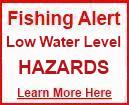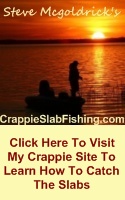
Go Fishing
Bass Bank Fishing
Like many Bassmasters I grew up fishing farm ponds, that is where I believe every fishing person gets their start. That is where I realized how big pond fishing can be and how rewarding it can be. Stop and think for a minute about the big reservior near your house, how hammered it gets every year from all the local fishing folks. I bet the fish have seen every kind of lure that is made. A 7 pound fish out of the reservior would be a trophy for sure.
Now look at a pond or gravel pit that is not fished with so much pressure and the fish are allowed to grow real big. This is where you get the Bass Hogs. I like to look for ponds that are 1/2 acre to an acre and ones that are not that deep. Granted, down south we need it at least 10 foot so when we get ice in the winter the Bass Hogs got a place to go. The next thing I like to do is walk around the pond and see what the Bass Hogs might be feeding on such as frogs, crawdads, minnows and insects. Pond bass eat a combination of aquatic and terrestrail forage, and a good mix of feeding opportunities always produces bigger fish. The next part we have cover mentioned in earlier articles that make the pond a big plus and that is grass, wood, rocks, trees and stumps in the water, surface or subsurface weeds, thick shore line grass, brushpiles; the more the better.
Look the pond over real close to find different indentations along the bank, points, and grass pockets. Most of the time most fisherman take the path that is used all the time and I do not recommend this approach. You will find out the hard way, by not catching any fish. Try and get into the hard to get places that will still keep you out of the water. I do not recommend wading because the bottom can be boggy and before you know it, you are sunk in to the hips in mud and no way to get free of the mud, not to mention watch out for those snakes. Water Clarity is another piece of information that will be needed. Murky ponds tend to be better in early spring because they warm up faster. As the summer approaches, start to look for what I call pea soup colored water which holds oxygen better. Also the water clarity will let you know what type of lures to be throwing. As I have mentioned in other articles, I would recommend Spinner Bait, Plastic Worm/Lizard, Topwater Bait, the Kelly Fisher Bait Company Xplodin Toad, buzzbait, and last a crankbait. One thing to keep in mind is listen to what the fish are telling you and keep alert to things that are going on around you. I like to approach the pond more or less tip toeing and will cast first down the side of the bank and then start toward the deep water at about 3 foot increments until I have saturated the area and some times I will start back in case I left a big one. The only other thing that I might advise is start off with the quietest lure first; you do not want to spook that Bass Hog then work the way up to the noisest lures. If you start off with a noisy lures, you will catch fish, but it will be the dinks and bucks, the small fish. Try out what I have written about and see if you do not see 8 pounders and better filling up you camera. Keep The Hooks Wet! Keep a log book on what the ponds are doing at that time of year and it will help you the following year to pinpoint which lake to hit. Steve McGoldrick
|
Home Brag Board Going Green Steve's Tackle Box Fishing Tips Fishing Equipment Bass Boat Tips Fishing A Lake Bass Fishing Spots Fishing Articles Bass Fishing Alerts Regulations and Licenses
|
©2014-2018FishingForHogs.com All Rights Reserved Worldwide
Privacy Policy/Terms of Service Cookie Policy Disclosure Policy




